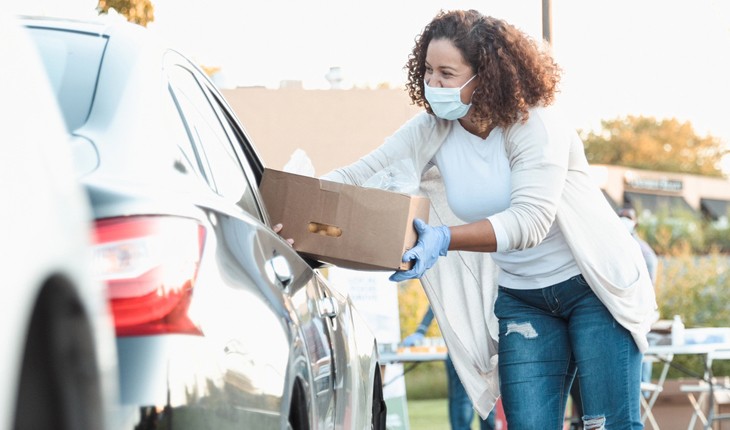The pandemic has worsened the already significant challenge many face accessing healthy foods all year long. Here’s how employers can help.

Thanksgiving and the winter holidays are often times for bountiful family meals. But this ideal is not the reality for many in New Jersey, possibly even for those in your own workplace who you may be surprised or even shocked to learn are hungry and uncertain about their next meal.
Food insecurity occurs because people don’t have the financial resources to access nutritious food that can keep them healthy. And it can happen to anyone, regardless of age, education or employment status.
“People don’t show up to work wearing a sign that says they’re food insecure,” said Carlos Rodriguez, President and CEO of the Community FoodBank of New Jersey (CFBNJ). “But many workers are.”
It’s hard to see how those with a job might still deal with the challenges of hunger. Today, about 800,000 New Jersey residents are food insecure. That’s close to 1 in 11 people. About 200,000 of them are children.
This problem has only gotten worse since the pandemic. About 13.5 percent of New Jersey residents were projected to be food insecure in 2020 because of the challenges brought by COVID-19. That’s up from 8.7% before COVID-19. These figures are more pronounced for communities of color. Nationwide, Black individuals were 3.2 times more likely and Latino individuals were 2.5 times more likely to experience food insecurity compared to white individuals.
The pandemic upended families’ budgets, even those who have members with full-time jobs. “You don’t know if their spouses or partners have lost their jobs and that source of income,” Rodriguez explained. “Or if they’re newer employees, what kind of financial hardship they had before coming to your workplace.”
Balancing food, health and survival
Individuals whose paychecks can’t keep up with the costs of living are associated with the acronym ALICE, which stands for Asset Limited, Income Constrained, Employed. They earn above the federal poverty level, but not enough to afford a bare-minimum household budget that accounts for housing, child care, food, transportation and health care.
ALICE households can move in and out of food security throughout the year. When they don’t have enough money for food, they may need to make difficult family decisions. Parents skip meals to feed their children, seniors give up food to buy needed medicine, and young adults may choose to fill their pantry rather than pay for education.
“There’s a saying, ‘Rent eats first.’ That means people are going to do whatever they can to pay rent and not become homeless,” Rodriguez said. “So to survive, people will sacrifice the quality, amount, and nutritional value of the food they buy.”
These decisions can pose a huge physical and mental toll on employees because hunger and health are deeply connected. Research has shown that for people who are constantly hungry, their brains go through trauma, Rodriguez said. “They can’t think clearly and they’re much less productive,” he added.
Chronic diseases such as diabetes and high blood pressure also disproportionally affect people who are food insecure. Hunger and food insecurity are also linked to many adverse effects to overall health.
Filling the food security gap
While food insecurity is a problem with several solutions, most are far from perfect and always seemingly behind the scope needed.
Last year, 60 million people participated in charitable food assistance, a 50% increase compared to 2019. In response, the USDA spent $4 billion on food for food banks in 2020, according to Feeding America.
In 2020, CFBNJ provided 83 million meals to more than 800 food pantries and soup kitchens across its 15-county service area – up from around 50 million meals in prior years. But in 2021, CFBNJ projects to deliver 93 million meals.
The increase is due to a number of reasons, Rodriguez said. The need is still great, as it can take years for a family’s income to recover from job losses. Also, CFBNJ is working to more equitably distribute meals to communities that need them most and ensure things like fresh produce is sent to where people can access it.
Plus, the price of food is going up. People are seeing a 4 to 7 percent increase in food costs. For example, the 20,000 extra turkeys CFBNJ plans to deliver this year cost an extra 35 cents per pound. And with these costs come a greater demand for CFBNJ’s services.
It’s only through the generosity – both in terms of financial support and volunteer hours – from individuals, corporations, foundations and communities that CFBNJ and similar organizations have been able to keep up with this increased demand.
For employers who want to sponsor an organization-wide effort to combat food security – or for individual employees who want to help out this holiday season or any time of the year – they can:
- Participate in America’s Grow-a-Row community harvests
- Volunteer at events hosted by the Community FoodBank of New Jersey and the Food Bank of South Jersey
- Visit Feeding America for more ideas
While workplace food drives are helpful, Rodriguez points out that cash donations make more of an impact because CFBNJ can procure food at very competitive rates. “Every dollar donated allows us to provide three meals,” Rodriguez said.
Helping our neighbors in need
At Horizon, we’re also doing our part to bring more food security to the people of New Jersey. The Horizon Foundation of New Jersey ramped up its support of the YMCA and Salvation Army to support distribution of food to those in need. And, Horizon volunteers served more than 100,000 meals for CFBNJ.
To help employees struggling with food insecurity, we’re here to support their whole health and address the social drivers that may contribute to hunger. Our innovative Horizon Neighbors in Health program can help.
This partnership between Horizon and several hospitals and doctors across New Jersey provides select members with a local Community Health Worker and a Personal Health Assistant to help with finding transportation, healthy foods, child care, employment and housing – social drivers that prevent people from achieving their best health.
Find out more about this program here, and to see how you support CFBNJ, visit cfbnj.org.













